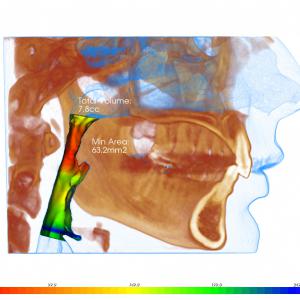
Obstructive Sleep Apnea (OSA) is a potentially life-threatening disorder that causes the airway to collapse either completely or partially, interrupting normal breathing during sleep and thus your ability to get oxygen to the brain and body.
Snoring is the most common symptom of OSA and should be taken very seriously. Snoring blocks normal airflow, and as millions of spouses, family members, and roommates of snorers can attest, it often interrupts their sleep as well.
Obstructive Sleep Apnea events can be full apneas which are complete closures of the airway which completely stop airflow for 10 seconds or more. OSA events can also be hypopneas, which are partial airway blockages that decrease airflow and reduce blood oxygen levels. Most OSA patients experience full apneas, hypopneas and other minor airflow limitations that don’t qualify as apneas or hypopneas but nonetheless still negatively impact sleep quality.
Patients suffering from apneas typically appear to be choking, gasping, or snorting while they’re asleep. Although snoring is a common symptom of OSA, it can also be causing a hypopnea and is thus a warning sign of a potential problem. This is so because snoring is an interruption of normal airflow.
Snoring can directly impact airflow and oxygen levels in the brain and body and interrupt sleep quality in both patients and their partners. For this reason, Chronic Snoring is commonly treated with Oral Appliance Therapy to give patients and their partners better sleep even if the person does not have diagnostic OSA.
It is impossible to know how damaging any individual’s snoring is without a sleep test. For this reason, we recommend that anyone with chronic snoring get a diagnosis. It’s an easy and very valuable test that can completely change your life. Unhealthy sleep will definitely impact your health overall, so if you think you might be suffering from Obstructive Sleep Apnea, you owe it to yourself to look into sleep testing and treatment.
Obstructive Sleep Apnea is defined as at least five apneas and/or hypopneas per hour of sleep. The number of apneas and/or hypopneas per hour is referred to as the Apnea Hypopnea Index, and it’s one of the things measured and calculated during a sleep test and confirmed by a board-certified sleep physician.
Depending on a patient’s Apnea Hypopnea Index number, their OSA is classified as mild, moderate, or severe. Mild OSA is indicated by an index of 5-15. Don’t let the word “mild” fool you; it still indicates a serious breathing disorder. Moderate OSA correlates with an index of 15-30, and severe OSA has an index of 30 or greater.
Oral Appliance Therapy can be prescribed as a first line of treatment for patients with mild-to-moderate OSA, but it can also be used as a CPAP alternative for severe OSA patients who do not tolerate CPAP well. Regardless of treatment modality, follow-up sleep testing is critical to determine whether the treatment is effective. Consistent compliance is a very important aspect to any treatment and that is why many patients are finding the dental appliance for sleep apnea to be the best option for them that they can consistently use.
Date: 05/18/2016